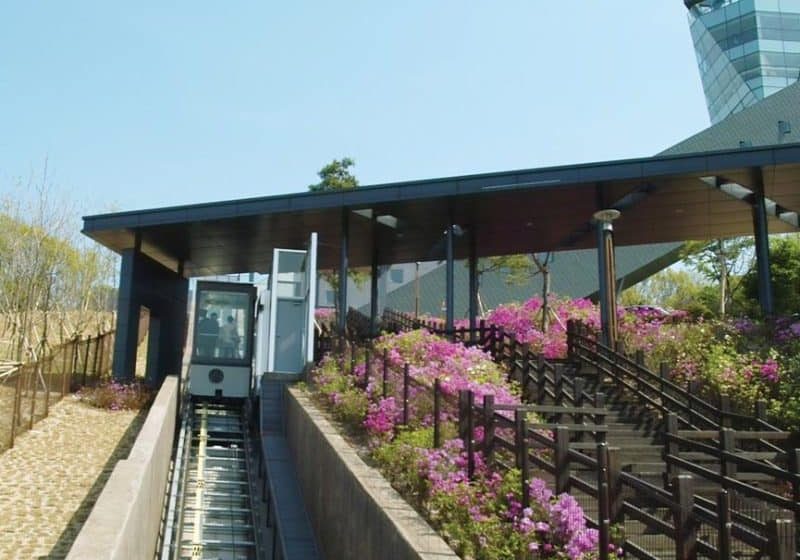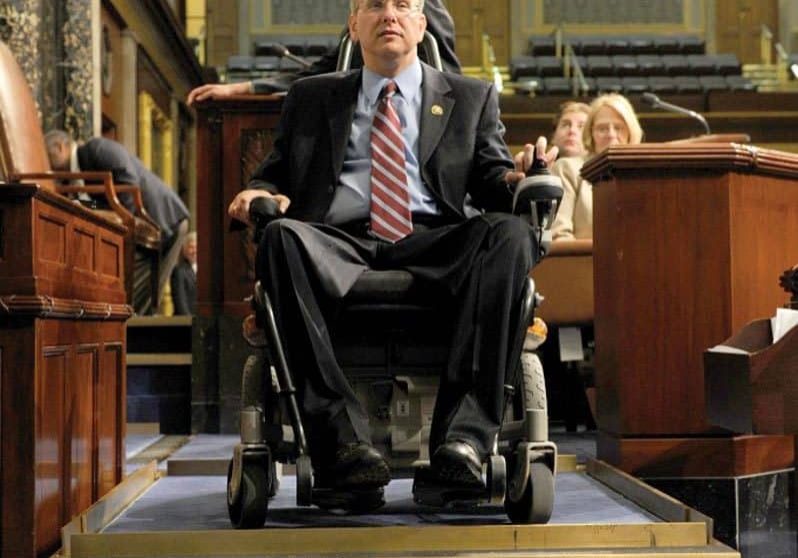A look at the effect of elevator weight reduction on brake behavior and the development of a brake control system to solve the problem.
Rikio Kondo1, Hiroshi Kigawa1, Takaharu Ueda2, Masunori Shibata1, Jun Hashimoto1, Akihiro Chida1 and Hideaki Marumo1
1Mitsubishi Electric Corporation, Japan
2Mitsubishi Elevator Europe, The Netherlands
This paper was presented at ELEVCON Lucerne 2010, the International Congress on Vertical Transportation Technologies and first published in IAEE book Elevator Technology 18, edited by A. Lustig. It is a reprint with permission from the International Association of Elevator Engineers IAEE (website: www.elevcon .com). This paper is an exact reprint and has not been edited by ELEVATOR WORLD.
Key Words: Elevator, brake, deceleration control, electronic safety, emergency
ABSTRACT
Weight reduction in elevator cars can contribute to energy saving and consumption of fewer resources. However, reducing a car’s weight induces higher deceleration during an emergency stop. Such higher deceleration also requires a large tractive force. To solve these problems, we have developed a brake control system that fulfills the general functional safety requirements based on IEC61508. The proposed system was validated with experiments.
1. INTRODUCTION
Weight reduction is a serious issue for transportation industries, such as automobile, train and airplane, because it directly affects the total consumption of energy and resources. For this purpose, lightweight structures and alternative materials, such as fiber reinforced plastics are widely used to reduce a system’s weight. For elevators, which are vertical transportation systems in buildings, this weight reduction issue is also of concern.
However, elevator systems have a specific problem during braking, which is closely related to the reduction in car weight. In the emergent condition, an elevator brake should not only stop the car immediately within a limited deceleration pattern, but maintain the car position after stopping (emergency stop). Reducing car weight increases deceleration in emergency stops and also increases the required traction. As the brake force should be designed to match the system requirements and national standards in each country, we have developed a brake control system to solve these problems.
2. EFFECT OF BRAKE BEHAVIOR DUE TO WEIGHT REDUCTION
Since an elevator brake stops a car within a limited deceleration pattern, the brake decelerates the car over a certain deceleration. Figure 1 shows a typical elevator system with single wrap drive and roping factor 1. With this system, the relation between weight reduction and car deceleration is considered. Generally, minimum deceleration occurs during an emergency stop when the counterweight portion of the rated load is below 50% and
Figure 1. Elevator model
the car runs downward with full-load condition. When the minimum deceleration is defined as Greq, the required brake torque T is derived by where Mmax is the maximum load, Mcar is the car weight, J is the inertia of the traction machine, h is the portion of the rated load, R is the radius of the driving sheave, and g is the gravity acceleration. These parameters are ignored in Eq. (1) since the total weight of the suspension rope and the compensation rope is small. Generally, the car decelerates at maximum during an emergency stop while running downward with no-load condition. In this case, The maximum deceleration Gmax is derived in Eq. (2).
(2)
(3)
Figure 2 shows the relation between the car weight and deceleration in Eq. (3). Greq (dashed line) is independent of the car weight. It is obvious that lower car weight causes higher deceleration for Gmax (solid line).
Figure 2. Dependence of deceleration on car weight
Next, the maximum tractive force is calculated in the same manner. When a car runs upward with no-load condition, the maximum tractive force Gtrac is required during an emergency stop. Gtrac is defined as deceleration in this case. Gtrac is derived in Eq. (4)
(4)
(5)
As h is below 0.5, Gtrac is always higher with less car weight Mcar. Traction is defined by Euler’s formula as follows.
, (6)
where, f is the friction factor, and a is the wrapped angle of the driving sheave by the rope. The left side of Eq. (6) is the traction, and the right side is the traction ratio between the car and the counterweight. Eq. (6) implies that reduction in car weight requires a higher tractive force due to a higher traction ratio, which is caused by lighter car weight Mcar and higher deceleration Gtrac in Eq. (5)
As mentioned above, reduction in car weight increases not only the maximum deceleration during an emergency stop but also the required tractive force. Continued
3. DEVELOPMENT OF BRAKE CONTROL SYSTEM
The problems described in the previous section are caused mainly by a larger brake force than what is actually required. Therefore, we developed a brake control system (BCS) that can maintain proper deceleration and adequate tractive force during an emergency stop.
3.1 Design Standard
During an emergency stop, a conventional system shuts down the power supplied to the brake and activates the brakes to stop the car. On the other hand, our BCS detects the emergent condition and controls deceleration adequately during the emergency stop, without defying safety requirements. To establish a secure design, the proposed BCS was developed based on IEC61508, which prescribes the general functional safety of electrical/electronic/ programmable electronic safety-related systems. The Japanese standard JISC0508 has already been issued in Japan, as translation of IEC61508.
3.2 System Configuration of System
Figure 3 shows the entire BCS configuration.
The BCS is mainly composed of the two main units. One is the brake control printed circuit board (Brake Control PCB), which is isolated from the car control printed circuit board (Car Control PCB), and the other is the electromagnetic brake that is activated by shutting down the power supply to the brake coil. The elevator system has an overspeed detection governor and a buffer in the pit.
The brake control PCB operates based on the instruction of the car control PCB in normal service. The brake control PCB detects an emergent condition by the signal of the safety circuit, and it stops the car immediately. During an emergency stop, the brake control PCB uses the encoder signal of the traction machine to precisely control the brake. The dual system of the brake control PCB compares with each other to guarantee its operation.
Figure 4 shows the main configuration of the brake control PCB.
Figure 4. Brake control PCB (printed circuit board)
The major devices in each block are described as follows;
Input: the instruction signal of the car control PCB, safety circuit signals, and dual encoder signals
Control: CPU, memory, watch dog timer (WDT), clock frequency monitor, and power supply voltage monitor
Output: safety relay and transistor chopper
The brake control PCB designed by IEC61508 has the following major self-diagnostic monitoring functions:
- mutual monitoring by comparing results from two CPU arithmetic operations
- software runaway with a watch dog timer in each CPU
- clock frequency in each CPU
- power supply voltage
- sensor fault by a mutual check of the two encoder signals
- fault of safety relays and transistor choppers
3.3 Control Method
Figure 5 shows the deceleration control method. The BCS controls the speed of the traction machine to follow the target speed pattern during an emergency stop. As the target speed pattern has a certain moderate deceleration, the BCS can decrease car deceleration better than the conventional system.
Figure 5. Control method with BCS
When an emergency is detected, the brake control PCB first generates a target speed pattern. Then, the brake control PCB detects the traction machine speed for every control cycle. It adjusts the brake-coil voltage with the chopper to control the speed using the BCS. When the detected speed becomes faster than the target speed, the brake force is strong; in the opposite case, the brake force becomes weak. In addition, the brake control PCB intercepts the power supply to the electromagnetic brake by shutting off the safety relays to prevent the car from overtravelling.
4. EXPERIMENTAL RESULTS
4.1 Effect of Proposed Control
In this section, experimental results are shown to validate our BCS of elevator systems. To clarify the effectiveness of the proposed system, a lighter weight car was used for the experiment. Therefore, the control’s effect on car weight reduction could be confirmed.
Figure 6. Experiment results
Figure 6 shows an example of the examination results. The car speed with a control is compared to the car speed without a control. When the brake control PCB detects an emergency at the time shown with the vertical dashed line, BCS begins to control the brake force. The result shows that the brake control PCB follows the target speed. Therefore, the car can stop with moderate deceleration.
4.2 Effect of Reduced Car Deceleration
It is important to determine a criterion for car deceleration. One way is to use average deceleration, but this is not appropriate against instant car deceleration. Another way is to use the maximum deceleration. However, the duration time of deceleration is ignored.
Therefore, we use the criterion based on impulse, referring to the evaluation of Eiband’s method [1]. However, we do not adopt the Eiband diagram, as the deceleration during an emergency stop by the traction system is obviously below it. Impulse P is derived by,
P = M x (g + Gif) x ∆ t, (7)
where M is the loaded weight, Gif is the upward acceleration when the impulse acts on M, g is the gravity acceleration, and ∆ t is the duration time of deceleration. Both Gif and ∆ t are only related to the deceleration motion of the elevator system in the coefficients of Eq. (7). Therefore, the evaluation index for the deceleration of the car, which affects impulse proportionally, is defined as ‘Gif x ∆ t’. The control effect was evaluated by comparing the relationship between ∆ t and Gif for the control condition with that for the no-control condition.
Figure 7 shows an example of the measured deceleration of the car, and the method of evaluating Gif and ∆ t from the deceleration profiles is explained as follows. The deceleration and duration time of deceleration were evaluated; the duration time that responds to action deceleration Gif1 was evaluated as ∆ t1 and ∆ t2, and to Gif2 as ⊿ t3. Though Gif1 has two durations, the longer one was adopted as the evaluated value because its impulse increased. Continued
Figure 7. Evaluation method of impact force
Figure 8 shows the results of deceleration and the duration time.
Figure 8. Impact force evaluation
Since the counterweight is heavier than the car, the car decelerates rapidly in the case of downward motion with no-load condition as shown with the thin solid line in . On the other hand, when the car moves downward with full-load condition, car deceleration is so low that the deceleration time (thin dashed line) becomes longer. However, since the proposed BCS is independent from the loaded weight conditions, the thick solid and thick dashed lines are quite similar.
The decelerations (or accelerations) that occur in normal service are of no matter (Figure 8). Then, focussing on the deceleration over the deceleration in normal service, the maximum decelerations are lower and the duration times are shorter in the control cases than that of the no control cases. Therefore, ‘Gif x ∆ t’ decreases and the impulse on M decreases with the control.
4.3 Effect of Rope Slip Prevention
Figure 9 shows the results of emergency-stop examinations during the upward motion with no-load condition. The examinations were executed in a car with further reduced weight, so that braking would cause a slip between the driving sheave and suspension rope. Without any control, the motor and the rope speeds split because of the motor’s rapid deceleration, that is to say, the rope slipped on the sheave. However, the rapid deceleration of the traction machine was prevented with the control, and the rope did not slip on the sheave during braking.
Figure 9. Tractive force evaluation
5. CONCLUSIONS
The developed brake control system is summarized:
1) Elevator cars using our developed BCS can achieve moderate deceleration and traction during emergency stops.
2) The reliable design of our BCS has been achieved based on international standards for programmable electronic safety systems.
3) The effectiveness of BCS was validated with a prototype system, and an impulse criterion was introduced to evaluate the deceleration control.
6. REFERENCES
[1] A. M. Eiband, “Human tolerance to rapidly applied accelerations: A summary of the literature,” NASA Memorandum No. 5-19-59E, 1959
Get more of Elevator World. Sign up for our free e-newsletter.









